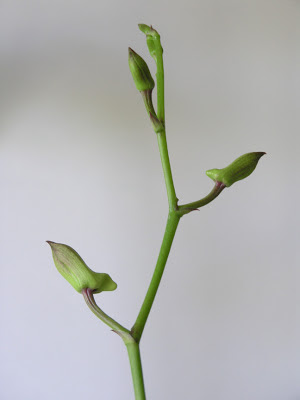 |
| The Trillium Trail at Thompson Wildlife |
Last weekend I went out to do field sketches for my certificate project. I sketched the yellow lady's slipper from life on The Trillium Trail last year, so it seemed a logical extension to focus on terrestrial orchids for the certificate project I'm undertaking at Brookside Garden's School of Botanical Illustration. For this project students are supposed to concentrate on three species of plants, using the processes we have learned to develop field sketches into a finished painting of each.
I knew I'd find my second orchid, the showy orchid, also called purple-hooded orchid or Kirtle Pink, (Orchis spectabilis or Galearis spectabilis) on the Trillium Trail at Thompson Wildlife Management. I had not seen any there when Herb and I visited the week before, but I was sure the orchids would be opening their curious flowers by this time.
It was overcast in Front Royal when I set out, and the Blue Ridge was veiled in cloud. As I started to ascend Freezeland Road the fog became so thick one could barely see five feet ahead in places. Normally we think of cloud forests being in Costa Rica or in the South American Andes--who'd have thought Virginia had its own cloud forest?
The forest was lovely in the mist, the fading trillium flowers changing to pink among the lush green understory. The progression of blooms from the previous week was amazing--the violet flowers had disappeared and the May-apples were beginning to take over the forest floor. The crystalline trills of birds echoed in the stillness.
It was quite chilly, so I pulled on my jacket and backpack and started down towards the Appalachian Trail, where I slowed down to a naturalist's pace to study the ground closely. I spotted one of the plants, then another, and another--the flowers were open, and the orchids plentiful!
 |
| Orchis spectabilis |
I selected one specimen and since there was not a soul around, laid out my waterproof poncho as a tarp to sit on the ground right in the middle of the trail, as close as possible to my subject. I was drawing intently, trying to keep the occasional raindrop from wetting my sketchpad when I heard a voice from behind say, "Hmmm, excuse me..." A hiker on the Appalachian Trail was trying to get by. I apologized, moved my gear out of the way as much as I could and asked him if he could step around me, which he managed to do loaded down with a huge, heavy pack.
I asked the gentleman if he was hiking the entire Appalachian Trail and he said yes, he'd started in Georgia back at the beginning of March. I wondered what his daily progress was like, and he responded that it varied, depending on the terrain and the weather, but he was averaging roughly 15 miles a day, and expected to reach the end of the trail in Mt. Katahdin, Maine by early August.
I allowed as someday I'd like to hike a good stretch if not all of the A.T., perhaps after I retire, and he confided that he had retired recently, adding that people were not often aware of the expenses associated with hiking on the A.T. How much did it cost? He had made a lot of his own equipment, but even then, it would cost about five thousand to fifty-five hundred to complete the circuit... then reflected that a 6-month vacation anywhere else would be much more expensive. I agreed.
 |
| Field sketch and notes. |
 |
| Color study done in the studio. |
After he left I went back to my sketch, and was finishing my notes when insistent chirps from above made me look up. A colorful small bird with bright orange markings sat on a branch very close to me. It flew away as I was taking my camera out of the case, but lingered nearby. I waited until the bird became visible again and snapped a couple of pix, which came out a bit blurry. I believe it was an American redstart, a small warbler that migrates through this area.
I picked up my gear and continued on down to the fire road loop and back up the hill, checking for yellow lady's slipper orchids along the way. Just as I had suspected, there were lots more flowers this week--I counted about a dozen in one stand, and more than 16 on the upper hillside where an older couple was photographing them. One plant had two flowers, just like the one I sketched last year. Squaw root was also emerging from the ground here and there. It finally warmed up enough on the trek uphill to shed my jacket. Back in the car, I looked down at the clock and was surprised to realize that four hours had elapsed--how time flies while sketching in a cloud forest! The clouds began to dissipate as I drove down the mountain and bright sunshine greeted me at the bottom in Linden.






























